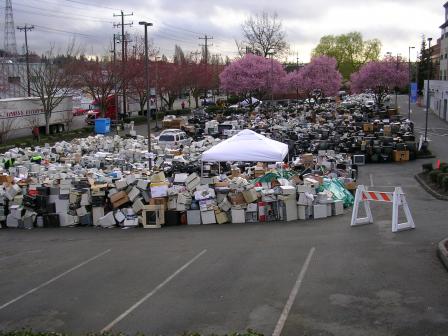Cathode Ray Tubes (CRTs)
A cathode ray tube (CRT) is the glass video display component of an electronic device (usually a television or computer monitor). EPA encourages repair and reuse as a responsible ways to manage CRTs. If reuse or repair are not practical options, CRTs can be recycled. Recycled CRTs are typically disassembled so that valuable materials can be recovered.
On this page:
Regulation of Cathode Ray Tubes
Due to the presence of lead located in the funnel glass, CRTs marked for disposal are considered hazardous waste under the Resource Conservation and Recovery Act (RCRA). However, CRT glass and used CRTs that are recycled or exported for recycling are not considered solid or hazardous waste under RCRA if certain conditions are met (See 40 CFR section 261.4(a)(22)).
Exporters shipping broken or unbroken CRTs to another country for recycling must notify EPA and receive written consent from the receiving country through EPA before shipments can be made. Exporters who ship used, unbroken CRTs for reuse as computers to another country must submit an annual notification to EPA.
It is important to note that state reulatory requirements for generators may be more stringent than those in the federal program. Be sure to check your state's policies.
Current Landscape of CRT Recycling
 CRTs collected for recycling in 2008CRTs and CRT glass were once easily recycled into new CRTs. However the demand for new CRTs has collapsed in favor of new flat panel technologies. Because of rising costs, negative economic incentives and shifts in CRT glass markets, some CRT processors and recyclers are choosing to store the glass indefinitely rather than send it for recycling or disposal, which increases the risk of mismanagement and/or abandonment of CRTs. EPA has begun a dialogue with all parts of the electronics recycling community – including manufacturers, recyclers, non-governmental organizations, and governmental entities – to encourage the identification and development of sustainable solutions to the CRT stockpile challenge.
CRTs collected for recycling in 2008CRTs and CRT glass were once easily recycled into new CRTs. However the demand for new CRTs has collapsed in favor of new flat panel technologies. Because of rising costs, negative economic incentives and shifts in CRT glass markets, some CRT processors and recyclers are choosing to store the glass indefinitely rather than send it for recycling or disposal, which increases the risk of mismanagement and/or abandonment of CRTs. EPA has begun a dialogue with all parts of the electronics recycling community – including manufacturers, recyclers, non-governmental organizations, and governmental entities – to encourage the identification and development of sustainable solutions to the CRT stockpile challenge.
Additional resources are available for those interested in EPA’s ongoing efforts to facilitate discussion within the electronics recycling community to help move towards a solution to the end-of-life management of CRTs.
CRT Rulemaking History
EPA made two major changes to CRT regulations in the Resource Conservation and Recovery Act (RCRA) in order to help ensure safe management of these materials. In 2006, EPA amended its regulations to encourage recycling and reuse of used CRTs and CRT glass (71 FR 42928, July 28, 2006). The amendments exclude these materials from the RCRA definition of solid waste when recycled under certain conditions. In 2014, the Agency further revised the requirements for used CRTs and CRT glass exported for reuse or recycling. The 2014 CRT Export Rule clarifies who is considered to be a CRT exporter and establishes procedural requirements that allow EPA to better track exports of CRTs for reuse and recycling (79 FR 36220, June 26, 2014).
